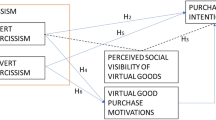Abstract
Virtual worlds, such as Second Life, World of Warcraft and Everquest, have demonstrated huge economic potential. In such virtual worlds, virtual items are bought and sold between individuals for real money. However, little empirical research has been conducted into players’ purchase behavior in virtual worlds. To help us gain a better understanding of factors influencing purchase behavior in virtual worlds, we embarked on an exploratory study. Four focus groups were conducted with 24 participants, selected according to demographic and experiential characteristics. Preliminary empirical evidence suggests that factors including effort expectancy, character competency, the quality of the virtual world system, social influence, virtual item resources, personal real resources, performance expectancy, and self-actualization are important for predicting virtual item purchase behavior in virtual worlds. The results showed that virtual item purchase behavior in virtual worlds has considerable variability involving a range of factors at different stages.
Similar content being viewed by others
References
Ajzen, I. (1991). The theory of planned behavior. Organizational Behavior and Human Decision Processes, 50(2), 179–211.
Bainbridge, W. S. (2007). The scientific research potential of virtual worlds. Science, 317(5837), 472–476.
Barnes, S. J. (2007). Virtual worlds as a medium for advertising. The Database for Advances in Information Systems, 38(4), 45–55.
Bhattacherjee, A. (2002). Individual trust in online firms: scale development and initial test. Journal of Management Information Systems, 19(1), 211–241.
Cheong, J. H., & Park, M. C. (2005). Mobile internet acceptance in Korea. Internet Research, 15(2), 125–140.
Davis, F. D. (1989). Perceived usefulness, perceived ease of use, and user acceptance of information technology. MIS Quarterly, 13(3), 319–339.
DFC Intelligence. (2007). Digital distribution key to online game market growth. Available at http://www.dfcint.com/wp/?p=14. Accessed 24 Aug 2008.
Doolin, B., Dillon, S., Thompson, F., & Corner, J. (2002). Perceived risk and the internet shop** experience in online purchasing behavior. In 7th annual CollECTer conference on electronic commerce, Melbourne, Australia, December 1–2, 2002.
Dahlberg, T., Mallet, N., & Oorni, A. (2003). A trust enhanced technology acceptance model—consumer acceptance of mobile payment solutions. In Proceedings of the CIC roundtable.
Edward, C. (2006). A cost-benefit analysis of real-money trade in the products of synthetic economies. Info, 8(6), 51–68.
Fishbein, M., & Ajzen, I. (1975). Belief, attitude, intention, and behavior: an introduction to theory and research. Addison-Wesley: Reading.
Gefen, D. W. (2000). E-commerce: the role of familiarity and trust. The International Journal of Management Science, 28(6), 725–737.
Hsu, C. L., & Lu, H. P. (2004). Why do people play on-line games? An extended TAM with social influences and flow experience. Information and Management, 41(7), 853–868.
iResearch (2006). China online game research report. iResearch: Shanghai.
Kim, Y., Oh, S., & Lee, H. (2005). What makes people experience flow? Social characteristics of online games. International Journal of Advanced Media and Communication, 1(1), 76–92.
Koufaris, M. (2002). Applying the technology acceptance model and flow theory to online consumer behavior. Information Systems Research, 13(2), 205–223.
Krueger, R. A. (1994). Focus groups: a practical guide for applied research (2nd ed.). Sage: Thousand Oaks.
DFC Intelligence et al. (2006). Korean game white paper. Available at http://www.southeastmedianetwork.co.uk/news/gstar.pdf. Accessed 24 April 2008.
Lee, H. Y., Ahn, H., & Han, I. (2006). Analysis of trust in the e-commerce adoption. In Proceedings of the 39th Hawaii international conference on system sciences, Hawaii.
Lee, M. K. O., Cheung, C. M. K., Sia, C. L., & Lim, K. H. (2006). How positive informational social influence affects consumers’ decision of internet shop**. In Proceedings of the 39th Hawaii international conference on system sciences, Hawaii.
Lin, J. C., & Lu, H. (2000). Towards an understanding the behavioral intention to use a web site. International Journal of Information Management, 20(3), 197–208.
Lehdonvirta, V. (2005). Real-money trade of virtual assets: ten different user perceptions. In Proceedings of digital art and culture, Copenhagen, Denmark.
MacInnes, I., Park, Y., & Whang, S. (2004). Virtual world governance: digital item trade and its consequences in Korea. In Proceedings of the 32th annual telecommunications policy research conference, Arlington.
Mahler, A., & Rogers, E. M. (1999). The diffusion of interactive communication innovations and the critical mass: the adoption of telecommunications services by German banks. Telecommunications Policy, 23(10/11), 719–740.
Manninen, T., & Kujanpää, T. (2007). The value of virtual assets—the role of game characters in MMOGs. International Journal of Business Science and Applied Management, 2(1), 21–33.
McKnight, D. H., Choudhury, V., & Kacmar, C. (2002). Develo** and validating trust measures for e-commerce: an integrative typology. Information System Research, 13(3), 334–359.
Moon, J., & Kim, Y. (2001). Extending the TAM for world-wide-web context. Information and Management, 38(4), 217–230.
Morgan, D. L. (1993). Successful focus groups: advancing the state of the art. Newbury Park: Sage.
Morgan, D. L. (1998). The focus group guidebook. In D. L. Morgan & R. A. Krueger (Eds.), Focus group kit (1). Thousand Oaks: Sage.
Maslow, A. H. (1943). A theory of human motivation. Psychological Review, 50, 370–396.
Powell, R. A., & Single, H. M. (1996). Focus groups. International Journal of Quality in Health Care, 8(5), 499–504.
Ramnath, K. C., & Paul, A. P. (2002). Perceived information security, financial liability and consumer trust in electronic commerce transactions. Logistics Information Management, 15(5/6), 358–368.
Starodoumov, A. (2005). Real money trade model in virtual economies. Available at http://papers.ssrn.com/sol3/papers.cfm?abstract_id=958286. Accessed 2 May 2008.
Teo, T. S. H., Lim, V. K. G., & Lai, R. Y. C. (1999). Intrinsic and extrinsic motivation in internet usage. International Journal of Management Science, 27(1), 25–37.
Venkatesh, V., Morris, M. G., Davis, G. B., & Davis, F. D. (2003). User acceptance of information technology: toward a unified view. MIS Quarterly, 27(3), 425–478.
Yee, N. (2005). Motivations of play in MMORPGs. In Proceedings of DiGRA conference, Vancouver, Canada, June 16–20, 2005
Author information
Authors and Affiliations
Corresponding author
Rights and permissions
About this article
Cite this article
Guo, Y., Barnes, S. Virtual item purchase behavior in virtual worlds: an exploratory investigation. Electron Commer Res 9, 77–96 (2009). https://doi.org/10.1007/s10660-009-9032-6
Published:
Issue Date:
DOI: https://doi.org/10.1007/s10660-009-9032-6




